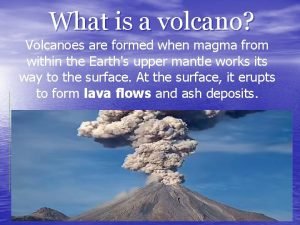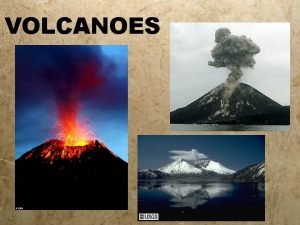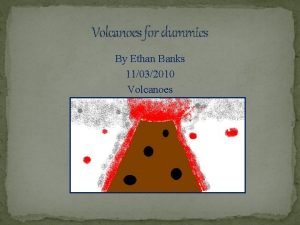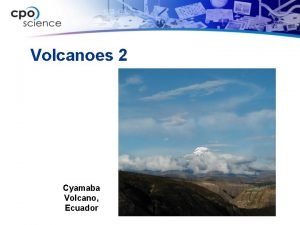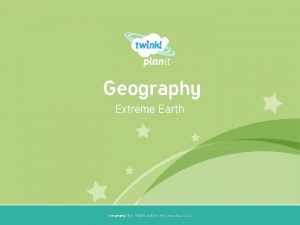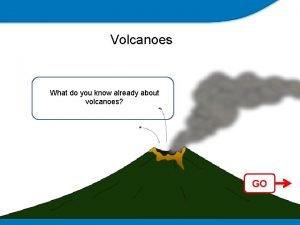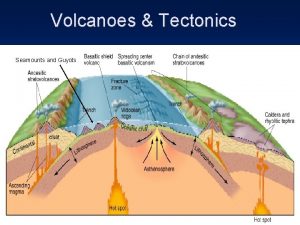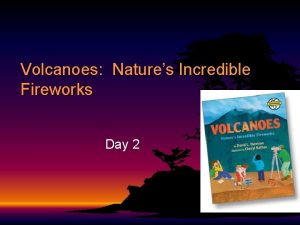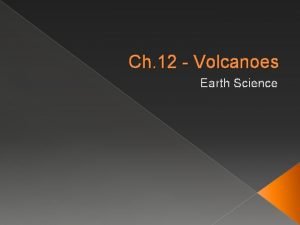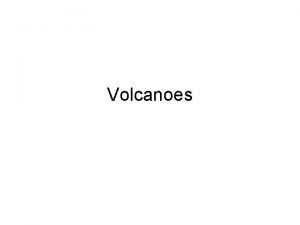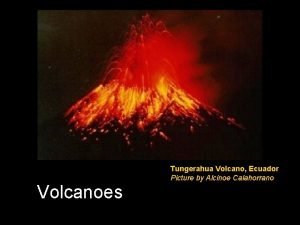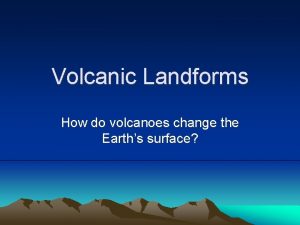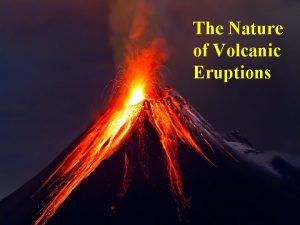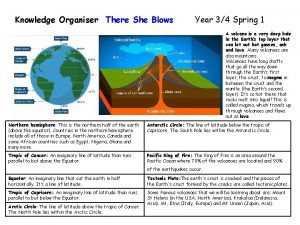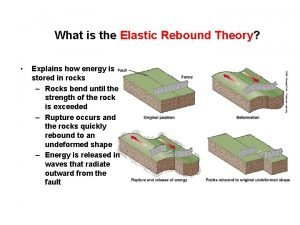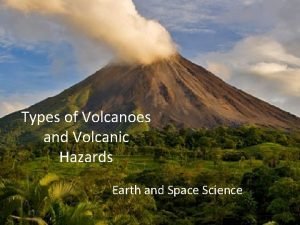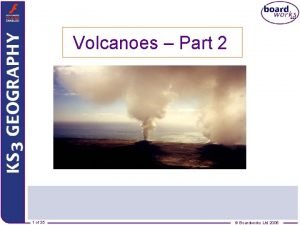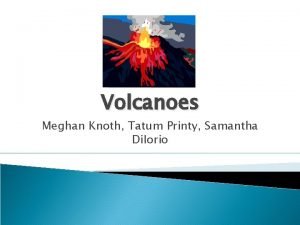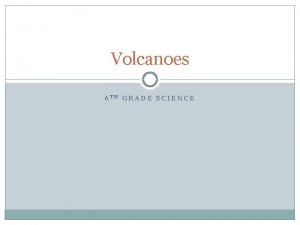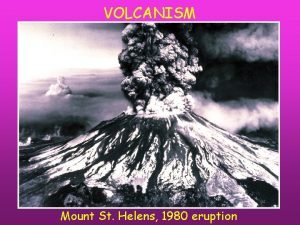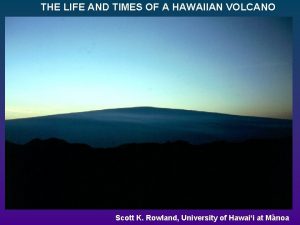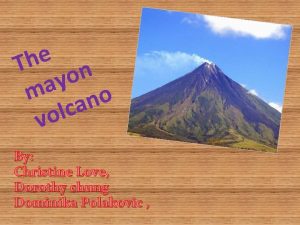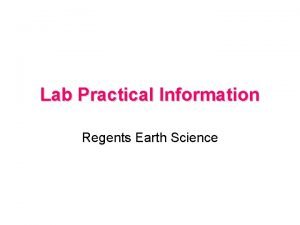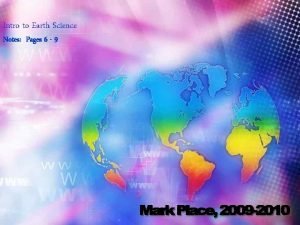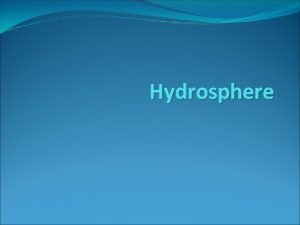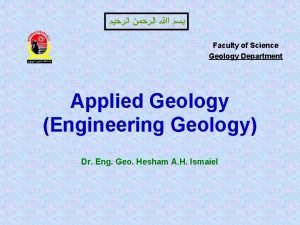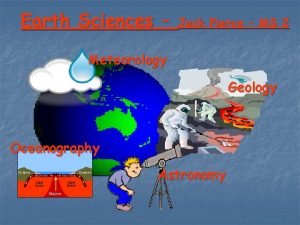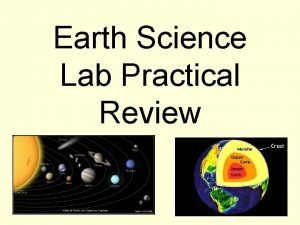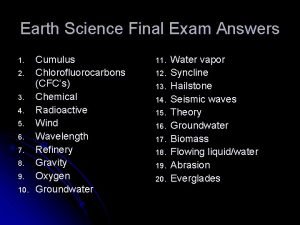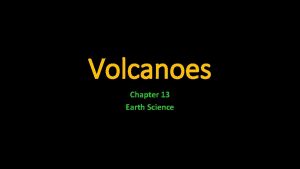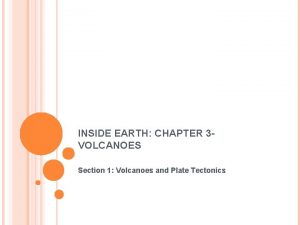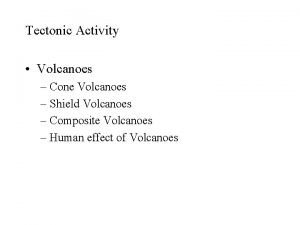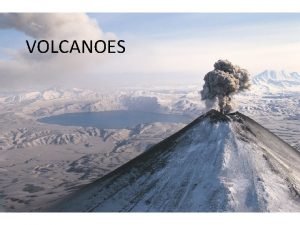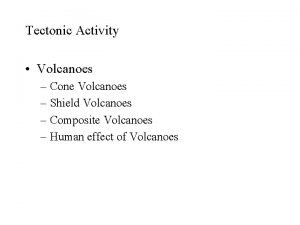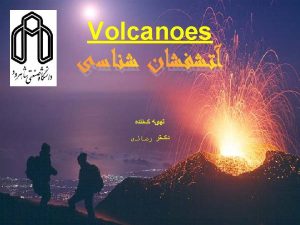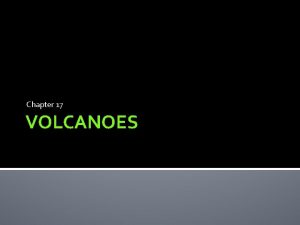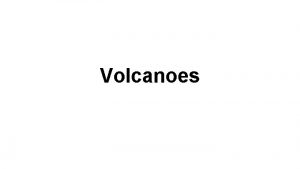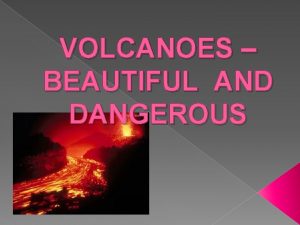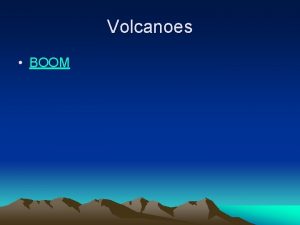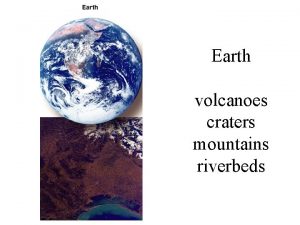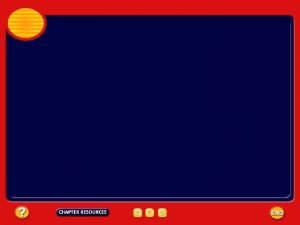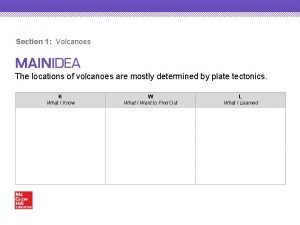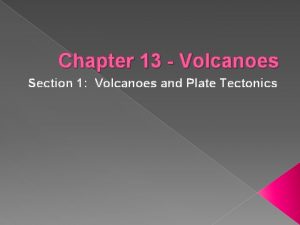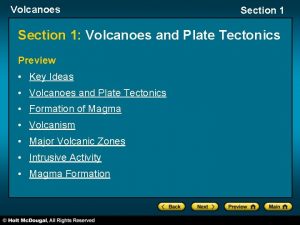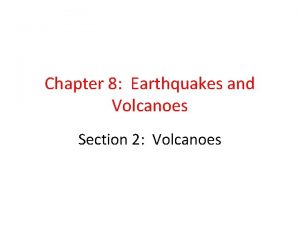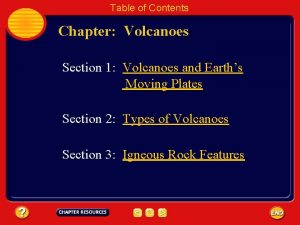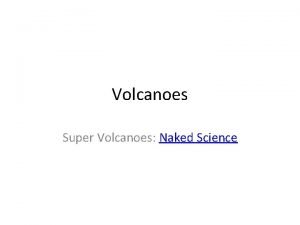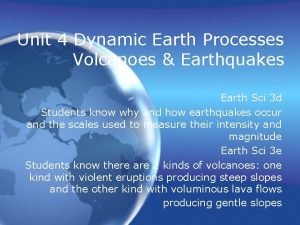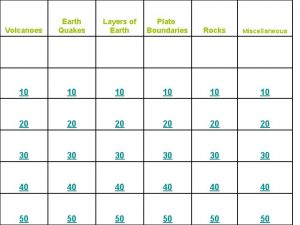Ch 12 Volcanoes Earth Science Section 1 Volcanoes














































- Slides: 46

Ch. 12 - Volcanoes Earth Science

Section 1 – Volcanoes and Earth’s Moving Plates � Learning Objectives: › Describe how volcanoes can affect people › List conditions that cause volcanoes to form. › Identify the relationship between volcanoes and Earth‘s moving plates.

Section 1 – Volcanoes and Earth’s Moving Plates � Volcano – opening in Earth that erupts gases, ash, and lava.

� B. Volcanoes can kill people, destroy property, and disrupt the environment. › 1. Lava and pyroclastic flows (very hot ash and debris) can bury cities and towns in their paths.

› 2. Sulfurous gases from volcanoes can mix with water vapor and create acid rain, which can kill organisms and pollute water.

(Not in notes) � How do volcanoes form? › Magma is less dense than the rock around it, so it is forced slowly toward Earth’s surface.


� C. Volcanoes form when magma flows out of a surface opening called a vent. � A steep-walled depression around the vent is called a crater.


Where do Volcanoes form? � D. Volcanoes often form where plates are moving together, or moving apart, or at hot spots.

› 1. The Mid-Atlantic Ridge is a divergent plate boundary that forms rifts through which lava can flow

› 2. At convergent plate boundaries, volcanoes tend to erupt more violently than they do in other areas.

› 3. At the boundary between Earth’s mantle and core, unusually hot areas form hot spots.

› Example of a hot spot Hawaiian Islands �The Pacific plate is moving over a stationary hot spot

Discussion Question � Where do volcanoes tend to form? Hint – 3 main areas

Discussion Question � Where do volcanoes tend to form? › Answer – �Where plates are moving together (convergent boundaries) �or moving apart (divergent boundaries) �or at hot spots

Section 2 – Types of Volcanoes � Learning Objectives: › Explain how the explosiveness of a volcanic eruption is related to the amount of silica and water vapor in its magma › List three forms of volcanoes

(Add to the top or bottom of your notes packet) � Two major factors that determine how violent a volcano will erupt… › 1. Amount of gas or water vapor in magma › 2. Amount of silica in magma Silica – compound made of the elements silicon (Si) and oxygen (O)

� A. The amount of water vapor and other gases present is one factor that determines whether a volcanic eruption will be quiet or explosive.

› 1. Gases can be trapped in magma by pressure of surrounding magma and rock; eventually they cause an explosive eruption. › 2. Magma at convergent boundaries can contain a lot of water vapor that can cause explosive eruptions.

� B. The composition of magma (specifically, the amount of silica) is a second factor affecting the nature of a volcano’s eruption.

› 1. Low-silica magma, called basaltic, is fluid and produces a quiet, nonexplosive eruption.

�a. Pahoehoe (Pa-HOY-hoy) lava runs down the side of a volcano ropelike structure �b. Aa (AH-ah) lava is a stiff, slow moving lava. Same kind of lava, just different speeds

› 2. High-silica magma is called granitic › Intermediate-silica magma is called andesitic They both produce explosive eruptions.

� C. Three types of volcanoes form from the three types of lava. Lava flows, hardens, and builds up over time forming volcanoes.

› 1. As quiet eruptions of basaltic lava spread out in flat layers, they form a broad volcano with gently sloping sides called a shield volcano.

› 2. As tephra (bits of rocks or solidified lava) falls to the ground, it forms a steep-sided, loosely packed cinder cone volcano. › Formed from explosive eruptions

› 3. A composite volcano forms from alternating layers of quiet lava and more explosive tephra. (Found at subuction zones)

� Review: › Shield volcano �Basaltic lava) Low silica �Quiet eruptions › Composite volcano �Low and high silica lava �Alternates between quiet and explosive eruptions › Cinder cone volcano �Granitic + intermediate lava) High silica �Explosive eruptions

Composite Shield

Discussion Question � What two factors account for the varying force of volcanic eruptions?

Discussion Question � What two factors account for the varying force of volcanic eruptions? › 1. Amount of gas or water vapor › 2. Amount of silica in magma

Section 3 – Igneous Rock Features � Learning Objectives: › Describe intrusive igneous rock features and how they form › Explain how a volcanic neck and a caldera form

� Intrusive Features – are formed underground � Extrusive Features – are formed at Earth’s surface

� A. Many intrusive igneous features form underground are later exposed › 1. Batholiths – rock bodies formed when magma bodies that are being forced upward from inside Earth cool slowly and solidify before reaching the surface.


� Example of a batholith Granite domes of Yosemite National Park Remember, Granite is a type of igneous rock which is formed from cooled magma

› 2. Dike – magma that hardens after being forced into a crack cutting across rock layers

› Sill – magma that hardens after being forced into a crack parallel to rock layers.

� B. A volcanic neck forms when the cone of an old volcano is eroded away, leaving the solid igneous core. (Devil’s Tower, Wyoming)

� Example of a volcanic neck Ship Rock, New Mexico

› 1. Caldera – large depression formed when the top of a volcano collapses.

� Example of a caldera Crater Lake, Oregon

› 2. Weathering and erosion wear down surface rock and expose igneous rock features.

Discussion Question � How are a dike and sill different?

Discussion Question � How are a dike and sill different? › Dike – forms from magma that hardens after being forced into a crack cutting across rocks › Sill – forms from magma that hardens after being forced into a crack running parallel with rocks
 What is my favourite subject
What is my favourite subject Description of volcano
Description of volcano How are volcanoes classified?
How are volcanoes classified? Paboeboe
Paboeboe Cotapoxi
Cotapoxi How are volcanoes made
How are volcanoes made What do you already know about volcanoes?
What do you already know about volcanoes? Guyots
Guyots Volcanoes nature's incredible fireworks
Volcanoes nature's incredible fireworks Explain the theory of plate tectonics.
Explain the theory of plate tectonics. Chapter 8 earthquakes and volcanoes
Chapter 8 earthquakes and volcanoes How are volcanoes formed
How are volcanoes formed Volcanic belts form along _____.
Volcanic belts form along _____. Active volcanoes map
Active volcanoes map Laccolith
Laccolith Paricutin materials extruded
Paricutin materials extruded Volcanoes knowledge organiser
Volcanoes knowledge organiser Explain the elastic rebound theory.
Explain the elastic rebound theory. Types of volcanoes
Types of volcanoes Ring of fire volcanoes
Ring of fire volcanoes Magma chamber
Magma chamber Shield volcanoes
Shield volcanoes Factors affecting magma viscosity
Factors affecting magma viscosity Name volcanoes
Name volcanoes Where are volcanoes
Where are volcanoes Volcanoes on oahu
Volcanoes on oahu Volcanoes of italy map
Volcanoes of italy map Interesting facts about mt mayon
Interesting facts about mt mayon Constructive forces and destructive forces
Constructive forces and destructive forces A pattern of meteorological symbols that represent weather
A pattern of meteorological symbols that represent weather Earth science sol 2010
Earth science sol 2010 Earth science lab practical review
Earth science lab practical review Earth science regents locating an epicenter
Earth science regents locating an epicenter Earth science lab practical
Earth science lab practical Earth science grade 9
Earth science grade 9 Dynamic equilibrium earth science
Dynamic equilibrium earth science Features of hydrosphere
Features of hydrosphere Fcat science 8th grade
Fcat science 8th grade Geology earth science definition
Geology earth science definition Final exam study guide environmental science
Final exam study guide environmental science Earth science meaning
Earth science meaning Geology earth science definition
Geology earth science definition Earth science sol review
Earth science sol review Zone of aeration
Zone of aeration Earth science sol review
Earth science sol review Earth science lab practical
Earth science lab practical Earth science semester 2 final exam answers
Earth science semester 2 final exam answers

